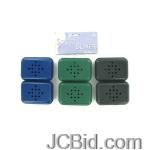
| Updated Blogs |
|
Computer Support Blog
Essensial Software for Web Based Support
HP Server and Desktop
HP ILO - Remote Tech-Support Software
More .....
|
 RSS Feed | Login
RSS Feed | Login http://www.pcakku.com
Nagelneu Laptop-Batterie, Laptop Akku online shop - pcakku.com
HP Compaq nw8200 Battery all-laptopbattery.com
By pcakku288 at 2018-04-21 09:55:07
Doubling the L1 and L2 cache bandwidth, by widening their access ports, and smartening up the core’s ability to cope with cache misses will help here, even though the cache sizes and structure remain unchanged. Meanwhile, Haswell adds new instructions - AVX (Advanced Vector eXtensions) 2 - to help handle multimedia data and the kind of numbers high-performance computing rigs crunch. Intel promises big performance gains in cryptography code, for instance.
Another new set of instructions, Haswell’s Transactional Synchronization eXtensions (TSX), help programmers take advantage of the chip’s ability to spot situations when the locks established by one thread to prevent another overwriting its data are not actually necessary. In which case, the overhead of locking and subsequently unlocking the data can be removed by ignoring the locks - technique called ‘lock elision’. With this ability, coders can insert lock code safe in the knowledge that if it’s not actually needed, there will be no performance hit. And they can add more locks without over-complicating their code.Haswell’s cores form only one small part of the chip’s die. A quad-core Haswell has a surface area of 177mm2, but only a third of that is taken up with those four cores. The remaining two thirds are split roughly half and half between the GPU, and the system logic and caches. Together all these elements comprise 1.4 billion transistors.
Haswell’s graphics core comprises generic front-end and back-end, with one or more “slices” in between, each of which contains eight execution units and associated caches and such. It’s the same architecture as Ivy Bridge, but expanded with a greater number of execution units and the addition of a new processing engine - a “Resource Streamer” in the jargon - to do a lot of the set-up work the CPU cores would once have handled. This increases the independence of the GPU, which is running on a separate clock from the cores, don’t forget. It can do more work without requiring the cores to be clocked up. The front end has been beefed up to keep extra slices pumped with data.Slices are independently power gated, by the way, so they can be shut down if they’re not needed.Intel currently has three Haswell GPU Variants: the HD 4600, HD 5000, Iris 5100 and Iris Pro 5200. The first contains a single slice; the rest have a second slice, essentially doubling the (undisclosed) number of execution units in the GPU. Slices work on individual groups of pixels on the screen, says Intel.The Iris Pro configuration will come in versions of Haswell that incorporate embedded RAM. The memory is in the chip package but not on the die, and Intel is not saying how much of it there will be. But it does say that the RAM cache is equally accessible to the chip’s cores and GPU through a low latency, high throughput connection. Intel engineers even claim it “enables discrete-class graphics performance”. No wonder Apple is rumoured to be particularly interested in the technology for future MacBook Airs and Pros.Even without the extra RAM, Haswell’s GPU will be able to support three displays simultaneously through a mix of DisplayPort, HDMI and VGA external links and internal connections to a laptop’s LCD. Resolutions of up to 4096 x 2304 pixels at 24Hz are supported, but you’ll be able to do the slightly lesser 3840 x 2160 at 60Hz, which is 4K x 2K. On the API side, Haswell will support DirectX 11.1, OpenCL 1.2 and OpenGL 4.0.
- HP Compaq nc8430 Battery
- HP Compaq nw8200 Battery
- HP Compaq nw8220 Battery
- HP Compaq nw8230 Battery
- HP Compaq nw8240 Battery
- HP Compaq nw8250 Battery
- HP Compaq nw8400 Battery
- HP Compaq nw9440 Battery
- HP Compaq nx4800 Battery
- HP Compaq nx5100 Battery
- HP Compaq nx6100 Battery
- HP Compaq nx6105 Battery
- HP Compaq nx6110 Battery
- HP Compaq nx6110ct Battery
- HP Compaq nx6115 Battery
- HP Compaq nx6130 Battery
- HP Compaq nx6140 Battery
- HP Compaq nx6300 Battery
- HP Compaq nx6310 Battery
- HP Compaq nx6310ct Battery
- HP Compaq nx6315 Battery
- HP Compaq nx6320 Battery
- HP Compaq nx6320ct Battery
For drawing and sketching, Apple also introduced the Apple Pencil, a new stylus for the iPad Pro that has been long in the works. It's optional and costs $99.The Apple Pencil is being sold as a super-accurate way of drawing on the screen. With pressure sensors, it can detect how hard you're pushing on the screen and change the width of the line you draw accordingly. With more advanced sensors on the tip, it can detect the angle of the pencil stroke, so it feels more like a real pen.You can rechage the Apple Pencil via an Apple-standard Lightning cable, which you can apparently plug straight into the iPad Pro.Apple Event iPhone 6S iPad Pro stylus
Apple PencilScreenshotThe Apple Pencil is supported by apps like the updated Notes and Mail, coming in iOS 9. Third party applications will also support it.In fact, Apple had Microsoft on stage to demonstrate the Apple Pencil working with Microsoft Office apps running on the iPad Pro. In that demo, Microsoft showed up how you can use an Apple Pencil for marking up Office documents and sharing the annotations.With iOS 9's multitasking features, Microsoft also showed off using the Apple Pencil to bring data across apps. Apple also brought up Adobe to show off a new suite of Photoshop apps running on the iPad Pro. With the Apple Pencil, graphics professionals get an easier, more responsive way to digitally edit pictures and photos. Apple Event iPhone 6S iPad Pro apple pencil Adobe ScreenshotA fully decked-out iPad Pro, at the top of the line and with both the Apple Pencil and the Smart Keyboard, would cost you $1347, which brings it into line both with Apple's mid-range laptops and the Microsoft Surface tablet/laptop hybrid device. Your everyday tablet is good for movie viewing, magazine reading, or game playing, but to get any sort of work done, you probably need to pair it with a keyboard. The problem is that, most of the time, adding an external accessory robs a tablet (or smartphone) of its portability. At that point, if you’re going to carry a keyboard and screen around to get stuff done, why not just use a laptop?You could have a hybrid like the Surface Pro 4 replace your notebook entirely, but if you don’t want to pay the premium for that shift, something like the iClever Foldable Bluetooth Ultra-Slim Mini Keyboard will let you do lighter work without making your mobile devices too annoying to take on the go.
As its clunky name suggests, this is a small standalone keyboard that you can fold up when it’s time to move. It can get especially compact when you do fold it, essentially getting to the size of a slightly thicker iPhone 6s Plus. At less than 0.4 pounds, it’s also fairly light. All of this means it’ll fit in many pants pockets, or, if nothing else, take up very little room in a bag. But despite its airiness, the board’s back is composed of a smooth brushed aluminum, which comes off as higher-grade than you might expect from something this affordable.The device pairs over Bluetooth with both iOS and Android devices (but not Macs, and it can be finicky with Windows PCs), and iClever rates its battery as lasting more than 80 hours with regular use. It automatically turns on whenever it’s unfolded, but, while it’d be nice to have an on/off switch or built-in battery light, it does go into a sleep mode when it’s left alone for 15 minutes.Actually typing with the iClever isn’t as luxurious as using a more spacious board, but that’s to be expected. For what it is, it’s fine. Its keys are fast, quiet, and sturdy, and its Function key gives you access to a handful of useful shortcuts; it’s totally usable for the casual tasks it’s meant for. Just try to use it on a flat surface.
- HP Compaq nx6325 Battery
- HP Compaq nx6330 Battery
- HP Compaq nx7100 Battery
- HP Compaq nx7200 Battery
- HP Compaq nx7300 Battery
- HP Compaq nx9020 Battery
- HP Compaq nx9030 Battery
- HP Compaq nx9040 Battery
- HP Compaq -nx9100 Battery
- HP Compaq nx9110 Battery
- HP Compaq nx9400 Battery
- HP Compaq nx9440 Battery
- HP Compaq nx9500 Battery
- HP Elitebook 2530p Battery
- HP Elitebook 2560p Battery
- HP Elitebook 2730p Battery
- HP Elitebook 2760p Battery
- HP Elitebook 6930p Battery
- HP Elitebook 8440p Battery
- HP Elitebook 8460p Battery
- HP Elitebook 8460w Battery
- HP Elitebook 8530p Battery
- HP Elitebook 8530w Battery
It’s worth noting that this looks like a white-label situation — a quick search for “foldable keyboards” on Amazon will bring up a wave of seemingly identical devices, all of which are taking after the Kickstarted Jorno keyboard, which goes for $100. So it’s hard to give iClever too much credit here. Nevertheless, this model’s been received well by PCMag, BetaNews, and others, and it currently holds a 4.5 rating after 210 Amazon user reviews. It works. If you want to make your tablet or smartphone a little more productive, this looks like a good, cheap way to start.Typically, affordable Windows laptops aren’t the most exciting devices in the world. They won’t hit your wallet as hard as the best notebooks on the market, but any cash you save is usually offset by chunkier, cheaper-feeling designs and a general sense of malaise in how they run. You have to dig pretty deep to find the good values among them.If you take the "Windows" away from the "laptop," however, the proposition becomes a little more interesting. Kickstarted by Intel’s Compute Stick, that’s exactly what a growing legion of so-called stick PCs are doing. They’re dongles, shaped like an Amazon Fire TV Stick or first-gen Chromecast, but inside their tiny frames is the same experience as a full-on Windows desktop.
Now, they aren’t particularly strong Windows PCs, and they require you to supply your own keyboard, mouse, and monitor, but they’re super affordable, usually retailing for $150 or less. If you wanted the all-encompassing benefits of a laptop — something you can use to stream movies, write up documents, browse the web, look at photos, and so on — in something more malleable than, well, a laptop, they have obvious value.The InFocus Kangaroo isn’t quite a stick PC, but for me, it’s a better take on the same general idea. It sacrifices the dongle form factor for a black, phablet-like rectangle, so while it’s not as portable, it’s still very easy to carry around. More importantly, that allows it to hold its own battery — it only lasts about 3-4 hours with ordinary use, but it’s still better than having to keep a power source connected at all times, as you do with most stick PCs.The Kangaroo is $100, which is about as cheap as these things go, but for that money it packs up-to-date versions of the same specs you’d find in those stick PCs. It has a 1.44GHz Intel Atom X5-Z8500 chip, 2GB of RAM, and 32GB of SSD storage. Only 18GB of the latter is usable out of the box, which is puny, but expandable through a microSD slot (or external hard drive).
Beyond that, there’s Bluetooth 4.0, 802.11ac WiFi, USB 2.0, USB 3.0, and HDMI ports through an included dock connector, and even a functional fingerprint sensor to use with Windows 10’s "Windows Hello" sign-in authentication tool. All of this runs on a complete, 64-bit version of Windows 10 Home, the same as you’d find on a Surface Book or Dell XPS 13.In other words, this is a real, live Windows PC. Things will start to chug if you open more than six or so tabs at once, and heavier programs like Photoshop are a no-go, but if you treat it the way you’d treat a budget laptop, the Kangaroo is actually relatively zippy. HD video and music stream smoothly, web browsing is fine with moderation, and I was able to run a few older games on Steam on lower settings.I wish InFocus could’ve added just a little more RAM, and the unit itself can get very hot after a while, but you can absolutely multitask with this. You can definitely do more than you would with a $100 tablet. You could even install Linux if you wanted. It’s never not a cheap Windows PC, but at this price it’s better than I expected.
Permalink | Comments (0)
Comments
To add a comment please login by clicking here




